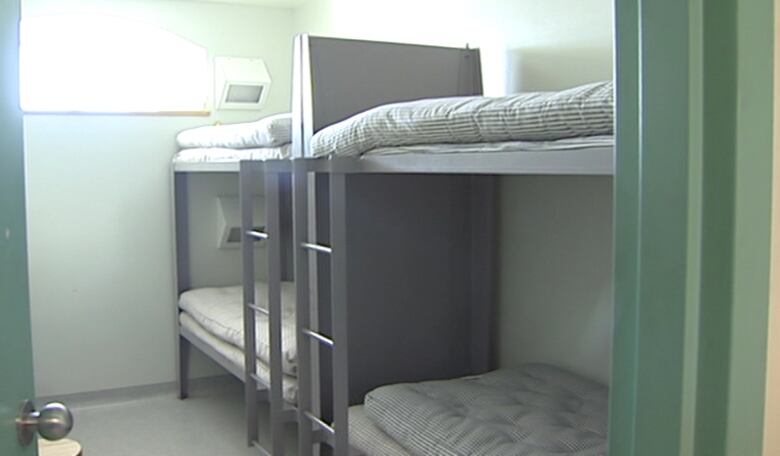PTSD in corrections: Former HMP officer says employer must do more
Department says mental health training available, more programs to come
Ian Sansford can't quite pinpoint oneevent that caused his post-traumatic stress disorder but many.
It may have been the bloody fights he witnessed over the course of his six-year stint as a correctional officer, the time he found a man dead in his cell, or when his truck was firebombed outside the walls of Her Majesty's Penitentiary.
- PTSD taking its toll on Canada's prison guards
- Read more stories by Ariana Kelland
- Prison workers protest management and working conditions
- Rebar shanks, exposed wires and intense violence: guard blows whistle at HMP
Whatever it was, it left a lasting mark, and led to the end of his short livedcareer in corrections at the age of 26.
After seeing a CBC Investigates story that pulled back the curtain on what is happening inside HMP, Sansford reached out to tell his story.
Sansford officially resigned from his post at HMP Newfoundland and Labrador's largest men's prison in September, but had been on leave since February 2014.

"I carried it home with mealotof the time," Sansford told CBC News from his home in Bridgewater, N.S.
"A lot of people have the idea that you leave your work when you walk out through the gate. I don't think it's possible for everybody it wasn't possible for me."
Sansford moved to the provinceat 19, and after several months at the West Coast Correctional Institute in Stephenville, movedto St. John's.
Firebombing
On day three in his new position, Sansford was face-to-face with an angry inmate, who had him pinned up againsta railing.
A nearby correctional officer stopped it from escalating any further just in time, Sansford said.
Ifelt like the departmentdidn'tcare that Iwasoff sick dealingwith issues that developed because Iwas working at a prison.- Ian Sansford, former HMP officer
"I'm pretty sure I would haveendedup going over the railing and it was probably a 10or15 [foot]drop and it would have done some serious damage to me if itwasn'tfor that officercomingback."
When he expressed his concern over the incident, Sansford said a manager told him maybe corrections wasn't for him.
But he didn't quit.
Sansford points to another incident when he witnessed a brutal beating between two inmates that he couldn'tstop.

A mug stuffed in a sock was used to viciously beat another inmate, Sansford said, and when that wasn't good enough a broomhandle was cracked off and used as a weapon.
"Ididn'tpanic but Iwas at the pointwhere Ifelt Icould stop it but wedidn'thave the numbers to go in on the range," he explained.
"We had to wait for several people toshowupand when we were waiting, this inmate was being stabbed in the face by thisbroomhandlerepeatedly."
In 2013, Sansford's truck was one of three vehicles firebombed in the parking lot of HMP. While the attack wasn't aimed at him, Sansford said it left him onedge as if being a correctional officermeant he had a target on his back.
"I just always felt that because I was acorrectionalofficer and that there were inmates who obviously get out of prison, they're on the outside now that they look for the opportunity perhaps to do some harm to a correctional officer."
A study cited on Corrections Canada's websitefrom 1992 indicates that, on average, a correctional officer is exposed to 28 critical incidents during a career. The study interviewed 122 guards.
Sansford said other than debriefings after serious incidents like when he found a man his age dead in a cell there was no help.
"The tipping point for me was finding this inmate dead and having to perform CPR on him ...he was only 24, he was a year older than me at the time," he said.
"That was just something that I wasn't prepared to see when I went in on the range, I was going into break up a fight and I open up a cell door and I see an inmate dead there and it was just complete shock for me."
A diagnosis of PTSD
Sansford became depressed and constantly hyper-vigilant.
If he went to a restaurant, Sansfordwould position himself in the best spot to survey the room, with his back against the wall in a corner.
Almost two years ago, his depression became too much to handle and he took leave. A doctor told him it wasn't just depression he had been battling, but PTSD.
"I had no idea that I could possibly havePTSD," Sansford said.
"I thought that was for [someone] in the militaryoverseasand stuff."

During the 18 months off work, Sansford said he received just one phone call from his employer (the Department of Justice and Public Safety) asking when or if he'd be returning to work.
"Ifelt like the departmentdidn'tcare that Iwas off sick dealing with issues that developed because Iwas working at a prison."
Sansford said he doesn't have the answers, but knows there needs to be support for those in his situation.
"I knew signing up as a correctional officer and starting my first day Iwas going to see some stuff Icould see anything Icould see a dead person in the middle ofthe night when Ilook in their cell, Ican see two inmates stab each other. But when it's happening right in front of you, it's completely different than how you imagine it."
As for his future, the chapter involving corrections is over, and he has moved back permanently to Nova Scotia.
Sansford's hoping to break into the healthcare sector, but not before letting the public know what prison guards face.
Meanwhile, the Department of Justice and Public Safety said it hosted lunch and learn sessions this past September with a psychologist who specializes in PTSD.
As well, the department said a wellness strategy is in the works for 2016 to deal with wellbeing, education and co-ordination of wellness resources. It also said there has been training offered in relation to mental health.














_(720p).jpg)


 OFFICIAL HD MUSIC VIDEO.jpg)
.jpg)



























































































